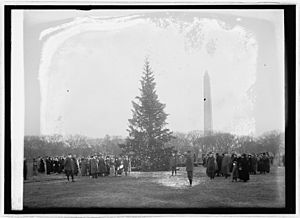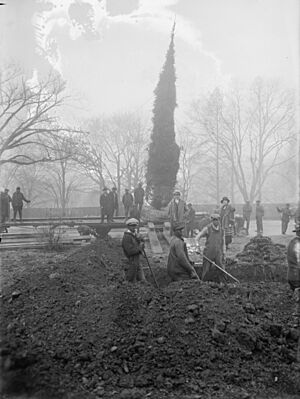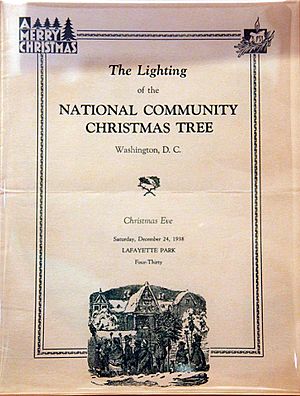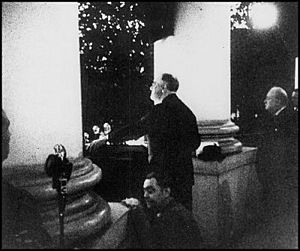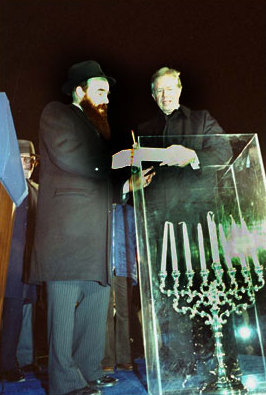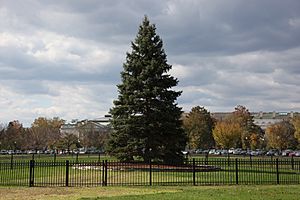National Christmas Tree (United States) facts for kids
The National Christmas Tree is a large evergreen tree located on The Ellipse near the White House in Washington, D.C.. An evergreen tree keeps its leaves or needles all year round. Since 1923, this tree has been decorated as a Christmas tree every year.
Each December, the President of the United States traditionally lights the tree. Every president since Franklin D. Roosevelt has spoken at this lighting ceremony. Since 1954, the event has also started month-long celebrations called the Pageant of Peace. Smaller trees around the National Christmas Tree represent the U.S. states, District of Columbia, and five territories. These smaller trees are known as the Pathway to Peace.
Quick facts for kids Lighting of the National Christmas Tree and the Pageant of Peace |
|
|---|---|
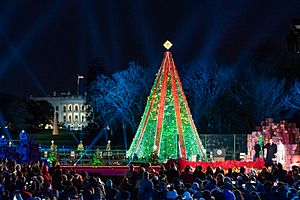
President and Mrs. Trump (right) just after lighting the 2018 National Christmas Tree
|
|
| Begins | December 1 |
| Ends | January 1 |
| Frequency | Annual |
| Location(s) | The Ellipse, Washington, D.C., U.S. |
| Years active | 1923–1941; 1945–present |
| Attendance | 17,000 (2011 approximate) |
| Organized by | National Park Foundation and Pageant of Peace, Inc. |
| Website | www.thenationaltree.org |
Contents
Starting the Tradition
The idea for an outdoor national Christmas tree came from Frederick Morris Feiker. He was an engineer and journalist. In 1921, Feiker worked for United States Secretary of Commerce Herbert Hoover. An electrical industry group wanted people to buy more Christmas lights. Feiker suggested that President Calvin Coolidge light the tree. This would make electric lights seem important and popular. Senator Frank L. Greene helped Feiker convince President Coolidge to light the tree.
The First Tree in 1923
Feiker arranged for Paul Dwight Moody, president of Middlebury College in Vermont, to donate a 48-foot (15 m) tall balsam fir tree. College alumni paid to ship it to Washington. The lower branches were damaged, so local evergreen branches were added.
Feiker gathered local groups to set up and decorate the tree. The U.S. electrical industry donated $5,000 worth of electrical cables. These cables were buried under the Ellipse to power the tree. First Lady Grace Coolidge approved the tree's location. About 3,000 school children were there to sing Christmas carols. The United States Marine Band played music. The National Broadcasting Company (NBC) broadcast the event on radio. The tree had over 2,500 red, white, and green electric bulbs. These were donated by the Electric League of Washington.
On December 24, 1923, a choir sang for two hours. At 5 p.m. (dusk) on Christmas Eve, President Coolidge touched a button. This lit the tree's lights and electric candles. He did not speak. A searchlight from the nearby Washington Monument also lit the tree. The Coolidge family invited people to sing carols on the Ellipse. Between 5,000 and 6,000 people came. Later, African American residents were allowed to see the tree. A Christian worship service was held. An illuminated Christian cross was shown on the Washington Monument.
The 1924 Live Tree
The 1924 ceremony was different. In April 1924, President Coolidge said cutting down trees for Christmas was not good. Feiker thought the ceremony would end. But his wife suggested using a live tree. Feiker and others invited Coolidge to light a live tree. He agreed.
Will H. Hays, who led the Republican National Committee, also owned a tree nursery. He arranged for a live, 30-year-old, 35-foot (11 m) Norway spruce tree. It arrived on December 13 and was planted on December 17. It was planted on the west side of Sherman Plaza. This is a public area south of the Treasury Building. The American Forestry Association planted the tree. It was decorated with 1,000 red, white, and green lights. The Electric League of Washington provided these lights. The Potomac Electric Power Company supplied the power. The tree was now called the National Community Christmas Tree. School choirs and the United States Army Band performed.
Coolidge used a switch at 8 p.m. to light the tree. This was the only year a switch was used; usually, a button is pressed. He and Mrs. Grace Coolidge stayed to sing carols. Dr. Jason Noble Pierce wrote a new carol, "Christmas Bells." It was for Mrs. Coolidge, whose son had recently died. The First Congregational Church choir sang it.
Trees from 1927 to 1933
For the next seven years, the ceremony stayed mostly the same. In 1925, the lighting was moved to 6 p.m. for children. In 1926, a flare was fired when the tree lit up. This became a tradition for a few years. In 1927, a bronze marker was placed at the tree's base. The tree had better lights and 2,000 light-scattering jewels. Colored floodlights also helped. President Coolidge gave a short speech, starting a new tradition. NBC broadcast carols from speakers around the tree.
In 1929, the tree was found to be badly damaged by the lights. A new 35-foot (11 m) Norway spruce was planted. This was the first time decorations, not just lights, were used. Scaffolding was used to decorate the tree to protect it. Lighter lights with lower power were used. A fence was put around the tree to protect its roots. The ceremony was at 6 p.m. That evening, President Herbert Hoover and Mrs. Lou Henry Hoover were with children. A fire broke out in the West Wing of the White House. Mrs. Hoover moved the children to safety. The President helped save furniture and papers. The West Wing was rebuilt.
The tree was damaged again in 1931 and replaced. A 25-foot (7.6 m) blue spruce was likely used. In 1931, a buzzer sounded when Hoover pressed the button. The button was not actually connected to the lights until 1980.
In 1932, President Hoover was away. Vice President Charles Curtis lit the tree. Loudspeakers hidden in the branches played carols every night. This "Singing Tree" was very popular. The tradition lasted for decades.
In 1933, the tree stood alone on Sherman Square. Other plants were removed for street widening. In early 1934, this tree was cut down. It was replaced with willow oaks.
Great Depression and World War II
In 1934, the National Christmas Tree moved to Lafayette Park, north of the White House. The 1931 tree was damaged. The National Park Service wanted to plant two new spruce trees. But the Commission of Fine Arts suggested two fir trees instead. Two 23-foot (7.0 m) Fraser firs from North Carolina were planted. They were placed east and west of the statue of Andrew Jackson. The western tree was chosen for the ceremony. President Roosevelt spoke, asking Americans to be brave like Andrew Jackson. The tree did not light up at first, but then the lights came on.
In 1935, the 24-foot (7.3 m) eastern tree was used. President Roosevelt joked about the previous year's delay. He asked Americans to unite like famous war heroes honored in the park. New star-shaped lights were used in 1935. Some were stolen. A temporary fence was built in 1936 to prevent theft. The lighting method changed to a switchbox by 1937. It was engraved with the names of all who lit the tree. In 1938, mercury-vapor floodlights were used to light the tree.
In 1939, the tree moved back to the Ellipse. The National Park Police said the Ellipse had more space. A 36-foot (11 m) red cedar was moved from Virginia. It was planted just before Christmas. (It was replanted at its old site after January 1, 1940.) This was the second-highest tree used. It needed 700 hand-colored bulbs, 100 glass stars, and floodlights. Over 8,000 people attended. The "Singing Tree" tradition stopped this year.
The 1940 tree was a 34-foot (10 m) red cedar. It had over 700 hand-colored lights and ornaments. It was also moved from Virginia and replanted later.
In 1941, the tree moved to the South Lawn of the White House. President Roosevelt wanted a more "homey" ceremony. Two 35-foot (11 m) Oriental spruce trees from the White House grounds were planted. They would be used in alternate years. After the Attack on Pearl Harbor on December 7, there were security concerns. But the ceremony went on. The east tree was used. On December 22, British Prime Minister Winston Churchill secretly arrived. He stayed with Roosevelt for a meeting. On December 24, 20,000 to 40,000 people entered the grounds. Security was very tight. Crown Prince Olav and Crown Princess Märtha of Norway were also present. Roosevelt and Churchill stayed for the whole hour-long program.
The National Christmas Tree was not lit in 1942. This was to save power and for security during World War II. It was not lit again until 1945. President Roosevelt still gave a radio address. Ornaments for the 1942 tree were red, white, and blue. In 1943, Eleanor Roosevelt asked for the ceremony to continue. Children contributed ornaments. Each ornament had a tag for an American soldier who was wounded, killed, or missing. Roosevelt was away in 1944, but Eleanor Roosevelt attended.
Post-War Trees and the Pageant of Peace
The lighting ceremony was first shown on television in 1946. The two Oriental spruce trees were again damaged. Officials suggested artificial trees, but the live tree industry opposed this. Television coverage grew in 1947 with NBC and DuMont. In 1948, more white bulbs were added for TV. A star-shaped tree topper with flashing bulbs was added. The "Singing Tree" returned.
From 1948 to 1951, President Truman lit the tree remotely from Independence, Missouri. Public attendance dropped. In 1952, Truman agreed to stay at the White House and light the tree in person. Even during the Korean War, crowds were allowed on the White House grounds.
Pageant of Peace and Pathway of Peace
The annual lighting ceremony grew in the 1950s. Millions watched on TV by 1953. People wanted to expand the event. For 15 years, it was a simple ceremony. A choir sang, a band played, and the president spoke. A Boy Scout and Girl Scout would greet the president. Then the public would leave. In 1952 and 1953, Catholic groups asked for a nativity scene. There was also pressure to move the ceremony off the White House lawn. Only 700 people were allowed on the grounds in 1953 due to security.
1954 started the Pageant of Peace. Edward M. Kirby, a public relations advisor, came up with the idea. He wanted a pageant of light, music, and art. This became a three-week series of nightly performances and religious events. The Board of Trade liked the idea because interest in the lighting ceremony was fading. The pageant meant moving the tree off the White House grounds. The lighting ceremony also moved from Christmas Eve to earlier in December. President Dwight D. Eisenhower approved the plan.
The 1954 Pageant of Peace was on December 17. The Ellipse became the site for the tree. Cut trees were used because a living tree would interfere with other events. The "pageant of peace" theme came from the Bible. Most goods and services were donated. Local architect Leon Chatelain, Jr., designed the site. Michigan State College provided the tree. Railroads transported it. Pepco supplied lights and power. Hargrove Display Decorators provided the nativity scene. States, territories, and embassies gave trees for the "Pathway of Peace." The National Park Service provided reindeer stalls and stages.
A concert by the Marine Band and a choir came before the 5:00 P.M. ceremony. The Pageant of Peace included a life-size nativity scene with live animals. There was an outdoor stage for singing groups and living pictures (tableau vivant). A "Children's Corner" had live reindeer. Children could donate toys there. Religious and secular entertainment happened nightly until January 6. Over 6,000 people performed. Twenty-two embassies took part. The tree was a 67-foot (20 m) balsam fir from Michigan. It had 2,100 red, blue, and gold lights. A white star topped it. The "Pathway of Peace" had smaller trees decorated by U.S. states, territories, and foreign embassies. Man-made snow covered the grounds. President Eisenhower lit the tree at 5:25 P.M. Six Boy Scouts and Cub Scouts from around the world joined him. Movie actor Robert Montgomery, Eisenhower's TV advisor, was also there. All major networks broadcast the event. The total cost was $30,000, mostly from donations.
The 1954 Pageant of Peace was a huge success. Over 6,000 people performed. Up to 20,000 people visited daily. Between 300,000 and 500,000 people saw the exhibits. Traffic was bumper-to-bumper. The pageant was so popular it was extended for two days.
National Christmas Trees: 1955 to 1972
In 1955, Pageant of Peace, Inc. was formed to manage the event. President Eisenhower was recovering from a heart attack. The 1955 tree was lit remotely. Hargrove Inc. began decorating the tree. Ten minutes after lighting, some lights went out. A worker quickly fixed it. Over 50 embassies took part in the Pathway of Peace. Attendance reached 540,000. In 1956, a record 51 embassies participated. In 1958, embassies were not invited to the Pathway to Peace, but they returned in 1959. That year, the grass was dyed green for the first time. A "Singing Christmas Tree" (a choir in a tree shape) performed behind President Eisenhower.
In December 1961, Vice President Lyndon B. Johnson lit the tree. President John F. Kennedy's father had a stroke. An electronic system changed the tree's lights with the music. The lighting was three days early because Kennedy was going to Bermuda. Only 16 states provided trees for the Pathway of Peace. President Kennedy lit the 1962 tree. The Pathway of Peace now had 52 trees, including all 50 states, Guam, and Puerto Rico.
The 1963 ceremony was delayed. President Kennedy was assassinated on November 22. President Johnson declared national mourning. The tree was lit on December 22. After a candle ceremony, Johnson lit the tree. General Electric began donating lights, changing the design yearly. The International Paper Company donated 80 small trees. They were arranged as a "Cross of Peace." No green dye was used in 1963 due to snow.
Changes happened throughout the 1960s. In 1964, the tree had 5,000 red bulbs and 500 gold ornaments. It was topped with a white cross. In 1965, it had multi-colored lights. The 53 Pathway of Peace trees had red and white bulbs. The American Mining Congress began providing these trees. In 1966, the Pathway trees were all green or all blue. They were arranged in an arc. In 1967, the National Christmas Tree had blue lights with red and white strings. It had gold balls and a 4-foot (1.2 m) gold spire topper. The Pathway trees returned to multi-colors. A Canadian choir performed for the first time. In 1968, the tree had blue, white, and yellow lights. When President Johnson lit it, another tree was lit remotely in Nulato, Alaska, a newly electrified village. In 1969, the Pathway of Peace had 57 trees, including all territories. The tree had red and white light bands. The ceremony was interrupted by about 200 Vietnam War protesters. They planted a "peace tree." Eight adults and a youth were arrested.
The 1970 tree, a 78-foot (24 m) blue spruce, had problems. The train carrying it derailed twice. The tree blew over in high winds. Lightbulbs exploded after a fireproofing liquid caused shorts. No anti-war protests happened at the lighting. Women Strike for Peace tried to display anti-war tombstones, but a court overturned the ruling. President Richard Nixon and a local child, Andre Proctor, lit the tree. A tree dedicated to prisoners of war (POWs) and soldiers missing in action (MIAs) was added.
Vice President Spiro Agnew lit the 1971 tree. Protesters briefly interrupted his speech. The tree topper was a white snowflake. The tree had red and white bulbs with gold lights. There were 56 trees in the Pageant of Peace, plus a POW/MIA tree. Agnew lit the tree again in 1972 with Eric Watt, a 10-year-old boy. Over 9,000 green bulbs, 1,000 clear bulbs, and 250 globe bulbs decorated the tree. The U.S. Army supplied floodlights. The tree stayed lit 24 hours a day. There were 57 state and territory trees. The American Mining Congress did not supply trees, so Pennsylvania did. Former President Harry S. Truman died on December 26, 1972. Performances were canceled on December 28. Anti-war protests happened on December 25 and 30.
National Christmas Tree: Living Trees Since 1973
First Living Trees: 1973 to 1977
After using cut trees since 1954, the Pageant of Peace brought back a living tree in 1973. People had been writing letters since 1965 asking for a live tree. This campaign grew stronger in 1969 and 1972. The National Park Service agreed to plant a live tree due to public pressure.
A 42-foot (13 m) Colorado blue spruce from Pennsylvania was donated. It was planted on October 11, 1973. The tree was damaged when it fell off the truck. This affected its lifespan. A bronze plaque was placed nearby. General Electric developed "cool lighting" to protect the tree. But due to the 1973 oil crisis, they used eight colored floodlights at the base instead. These lights reflected on the tree to avoid heat damage. The tree's 36-inch (91 cm) gold snowflake topper was lit from within. To save energy, the tree was lit only from 5 P.M. to 10 P.M.
The energy crisis also changed the 1973 Pageant of Peace. The Park Service used no cut trees. Instead, 57 live trees were planted on the Ellipse. After the pageant, these trees were replanted in D.C. parks or donated to states. They were decorated but had no lights. Only footlights were used for safety. A court ruled that the Christian nativity scene could not be part of the pageant. So, local residents displayed their own nativity scenes nearby. One included sheep, a donkey, and a calf. Another had live actors and animals like camels.
In 1974, energy-saving lights were used. Over 2,000 tiny amber and white lights used less power. Braided gold rope and large gold ornaments were also used. The Pageant of Peace still had 57 trees. Three different groups provided nativity scenes away from the main festival.
In 1975, the tree had a Bicentennial theme. It was decorated with 4,600 red, white, and blue lights and ornaments. A 4-foot (1.2 m) gold and green Liberty Bell topped it. These lights used 40 percent less power. Thirteen tall evergreen trees symbolized the Thirteen Colonies. Another 47 smaller trees formed the Pathway to Peace. Three organizations again provided nativity scenes. In 1976, the tree had 2,500 red lamps, representing "Youth." The Pageant of Peace had entertainment only until December 23. There were 60 trees in the Pathway to Peace.
By December 1976, the tree planted in 1973 was dying. Many lower branches were dead. Government experts said it had root damage and did not do well in Washington's climate. A citizen donated branches from his blue spruce. These were wired to the dying tree to cover damage. Many people offered new trees.
The 1974 tree was removed in 1977. An anonymous resident donated a 34-foot (10 m) blue spruce. It was planted on November 3, 1977. President Jimmy Carter, with his daughter Amy, lit the tree on December 15. It had 2,000 green lamps, symbolizing "Hope," and 500 "twinkle lamps." Due to the energy crisis, it was lit only from dusk to midnight for some days. This saved 74 percent more energy. A petting zoo was added to the Pageant of Peace.
However, the 1977 tree did not last. In January 1978, severe storms hit Washington. Winds of 62 mph (100 km/h) blew. Park Service officials feared the tree would fall. They attached guy-wires to brace it. But the tree was nearly uprooted and leaned at a 45-degree angle. Officials feared it had severe root damage and would not survive.
Third Living Tree: 1978 to 2010
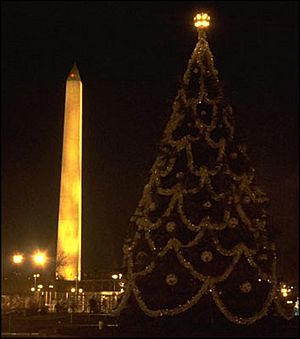
The National Park Service studied to find a tree that could thrive in Washington's climate. They traveled over 2,000 miles (3,200 km). A 30-foot (9.1 m) blue spruce from York, Pennsylvania, was chosen. It was planted on the Ellipse in 1978. A second, smaller spruce was planted as a spare. New, stronger cables braced the tree against winds. The bronze plaque was updated with the new planting date.
First Daughter Amy Carter topped the tree on December 5, 1978. This started a new tradition of a President or Vice President's family member topping the tree. President Carter, with his wife Rosalynn and Amy, lit the tree on December 15. It had 1,600 low-watt gold lamps, gold floodlights, and red ornaments. Each state and territory had a tree on the Pathway of Peace. The petting zoo and live reindeer returned. There was also a tree for senior citizens and a "community tree."
In 1979, the tree was only partly lit. When Amy Carter flipped the switch, only the star lit up. The state trees had tiny blue lights. President Carter said the tree would stay dark until the American hostages in Iran were freed. The theme was "Hope and Light," celebrating Thomas Edison's light bulb invention. The tree had silver balls and white garland. There were 50 smaller trees, one for each hostage.
1979 also saw the first National Menorah for Hanukkah. The 30-foot (9.1 m) steel menorah was Rabbi Abraham Shemtov's idea. President Carter helped light it in Lafayette Square. By 1987, it moved to The Ellipse. A new aluminum menorah replaced the steel one in 1998.
The National Christmas Tree stayed mostly unlit in 1980. President Carter's grandson, Jason, switched it on. The lights shone for 417 seconds, one second for each day the hostages were held. Then they turned off, leaving only the star. When the hostages were released on January 20, 1981, the tree was redecorated and relit for them. In 1980, Pageant of Peace organizers had to hold public meetings for input. A separate tree honored American POWs.
Due to security, President Ronald Reagan lit the tree remotely from the White House in 1981, 1982, and 1983. Protesters for the Equal Rights Amendment and aid for the poor were at the event. The 1981 tree lights had faulty wiring and could not be lit on the last night. In 1981, the petting zoo was canceled due to cost. But for the first time, each state or territory donated ornaments for their tree. A new contractor, Westport Marketing Group, managed the ceremony. They invited more national celebrities to make it a national event.
In 1984, First Lady Nancy Reagan lit the tree from the stage. Westport Marketing Group wanted to sell ornaments to raise money, but this was not allowed. President Reagan returned to the ceremony in 1985. He and Nancy Reagan lit the tree remotely from the White House South Portico. A large video screen showed them. The Community for Creative Non-Violence (CCNV), a group for the homeless, sued to include a statue of homeless people. A judge ruled against them. The statue was put outside the fence on Christmas Eve. Reindeer were not present due to cost. "Reindeer" (actually fallow deer) returned the next year.
President Reagan lit the tree from inside the White House in 1986, 1987, and 1988. The 1987 ceremony was early due to Soviet leader Mikhail Gorbachev's visit. Opposition to the nativity scene and menorah continued. CCNV again tried to include their statue, but failed.
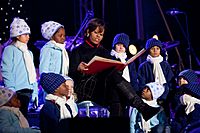
President George H. W. Bush lit the tree from the Ellipse platform in 1989. In 1991, President Bush was joined by five Americans freed from kidnappers in Lebanon. United Nations Secretary-General Javier Pérez de Cuéllar was also there. One of the freed hostages tried to light the tree twice but failed. Bush tried, and after a few seconds, the lights came on. In 1992, the first official National Christmas Tree ornament was allowed. It was designed by Peggy Henkel and given away for free. The tree was also on the official White House Christmas card.
Changes were made in 1993 and 1994. A G scale model railway was placed around the tree's base in 1994. A study showed solar lighting could be used. The United States Department of Energy donated solar lights. In 1994, official National Christmas Tree items were sold for the first time. Proceeds funded the Pageant of Peace.
In 1995, the tree was lit by solar power at night. The United States federal government shutdown of 1995 and 1996 canceled the Pageant of Peace from December 16. The National Park Service kept the tree lit. They also stopped displaying live deer. In 1996, the Office of Surface Mining stopped donating trees. Organizers had to buy cut trees. They also sold limited-edition art prints to raise money. The President's Park unit of the National Park Service began managing the music.
The National Christmas Tree Association provided cut trees in 1997. More art prints were sold. In 1998, tree grower Ron Hudler began donating cut trees. Polk Aristo-Craft provided the model train. Refreshments were sold for the first time.
To celebrate the millennium on December 31, 1999, the tree's lights turned white at midnight. The next year, the model train display expanded. A new wrought iron fence replaced an old chain-link fence.
After the September 11 attacks, the United States Secret Service restricted access to The Ellipse. Only ticket holders were allowed for the December 6, 2001, lighting. These rules were lifted 10 days later. Access points were limited. The original gold, green, and red lighting changed to patriotic red, white, and blue. The model train was provided by Aristo-Craft and model train groups. Clowns, a magician, and a juggler were added.
Major changes to lights and ornaments happened after 2001. In 2002, the tree had gold, green, and red lights again. Light-emitting diodes (LEDs) were used for the first time. Two strands of red LED lights were used. The tree used enough power for two homes. In 2003, for the 80th anniversary, 13,000 incandescent blue, gold, green, and red lights were used. In 2004, holographic suncatchers were used as ornaments. A blue, gold, green, and red lighting scheme (15,000 bulbs) was used, emphasizing patriotism. A 3D star topped the tree. The 2005 design used 25,000 clear white lights. It had 105 large snowflake ornaments and a 3D snowflake topper. Suncatchers were used again. A traditional design returned in 2006 with 25,000 blue, green, orange, purple, and red lights. Its 125 round ornaments had reverse-painted glass and gold holographic material. The 3D star topper was reused.
In 2007, LEDs replaced incandescent lights on the tree. The red garland also used LEDs. The tree was 100 times more energy efficient. The ornaments were 125 red bows. SABIC Innovative Plastics donated the material for the ornaments. That year, the ceremony was officially named "Lighting of the National Christmas Tree." The Pageant of Peace was renamed "The National Christmas Tree and Pathway of Peace." LEDs were used on state trees in 2008, saving 50 percent more electricity. A Santa's workshop was added. The lighting ceremony was dedicated to Ron Hudler.
The 3D star topper from 2006 was still used in 2011.
Recent Replacement Trees: 2011 to Present
On February 19, 2011, the National Christmas tree fell in a windstorm. Its trunk snapped. The National Park Service knew the tree was at risk. A new 26.5-foot (8.1 m) Colorado blue spruce was planted on March 19, 2011. It came from a nursery in New Jersey.
On May 5, 2012, this blue spruce was declared dead. The Park Service said it died from "transplant shock." The hot summer of 2011 and mild winter also played a role. The dead tree was cut down. The NPS had already found a replacement.
On October 27, 2012, a 28-foot (8.5 m) Colorado blue spruce from Virginia was planted. The Park Service planted it even though Hurricane Sandy was approaching. They felt it was safer in the ground. Wires were attached to stabilize it. A special base protected the roots from flooding.
For the first time in 50 years, there was no Yule log in 2012. The performance stage was smaller and moved. This interfered with the Yule log pit. The model railroad, nativity scene, Santa's Workshop, and state trees remained. The Yule log pit is now covered.
The lighting scheme changed in 2013. General Electric provided the lights, using LEDs for the fourth year. New "sugar plum lights" in blue, green, and red were added. A garland of twinkling white spherical ornaments was also added. These ornaments were lit during the day. The star-shaped topper was rebuilt to be brighter. The scheme used 60,000 LED lights and 265 ornaments. It weighed hundreds of pounds and used 5700 watts of power.
In 2013, CNN called the National Christmas Tree the sixth most beautiful in the world.
The 2015 tree had amber and white lights that twinkled. The state and territory trees had the same colors. They were decorated with ornaments from their respective areas.
On October 26, 2019, a new tree was planted. The U.S. government paid $163,984 for this 30-foot (9.1 m) Colorado blue spruce from Palmyra, Pennsylvania. This was the sixth living tree planted at the site.
Locations of the National Christmas Tree
The National Christmas Tree is a living evergreen tree. It is planted on the Ellipse in President's Park. It is near the Zero Milestone. In 1974, a low stone wall was built around the tree to protect its roots. In 2001, a cast-iron fence was built about 30 feet (9.1 m) from the wall. This protects the soil from visitors.
A temporary gravel road is built each year for workers to decorate the tree. A wooden snow fence is also installed. This protects the lawn during busy times.
The National Park Service says the National Christmas Tree event is historically important. It helps protect the Ellipse's history. The tree has become a key part of President's Park South. Visitors can also see the White House lit up for Christmas.
A "backup National Christmas Tree" is sometimes mentioned. This tree is southwest of Ellipse Road. It was planted as a replacement. However, this tree is not historic and did not grow well. By 2010, it was no longer considered a backup. When cut trees were used, four trees were selected. One was the main tree, two were backups, and the fourth provided branches for bare spots.
Cut evergreen trees were used in 1923, and from 1954 to 1972. Living trees were used from 1924 to 1953, and again from 1973 to the present (2019). The type, height, and source of these trees have changed a lot over time.
Organizing and Decorating the Tree
Designing and organizing the National Christmas Tree and Pageant of Peace takes a whole year. In 1999, the Washington Post reported that General Electric (GE) lighting designers start planning in March. By 2004, they started in February. GE changes the design every year. The lights are made in Cleveland, Ohio. They are tested on a tree at GE's headquarters in mid-October. This makes sure the design looks right and works.
Contractors ask for ornaments for the Pathway of Peace trees. They usually follow a theme. Other vendors contact famous singers and performers. They also contact companies with children's characters, like Warner Bros. Animation or The Walt Disney Company. Various contractors build the decorations. In 2000, Brilliant Electric Sign Co. built 200 ornaments in four weeks. Many decorations in 2000 and 2002 were made from the same high-tech plastic used for astronaut helmets.
During the summer, National Park Service workers spray the tree with a pesticide. This kills red spider mites that can harm evergreen trees. They also check for rodents in the roots or branches. The tree is pruned every year. It is fertilized every three years.
The 8-foot (2.4 m) Fraser Firs for the Pathway of Peace are cut in early November.
Hargrove Inc., a company that makes exhibits, starts decorating all the trees about 10 days before the lighting ceremony. Since 1954, Hargrove has decorated the tree every year. The lights and decorations do not hang directly from the tree branches. Instead, they hang from guy-wires that go up the sides of the tree. In 2008, 15 people decorated the tree.
The tree can have different numbers of lights each year. In 1999, 5,000 feet (1,500 m) of lights with 75,000 bulbs were used. In 2000, 125,000 lights were used. In 2002, there were 200,000 bulbs. But in 2003, only 13,000 were used for a more traditional look. In 2008, after switching to LED lights, the tree had over 45,000 lights. About 34,000 LEDs were on the branches. By 2010, the number of LEDs increased to 81,104. The tree and Pathway of Peace trees used 7,000 watts over four weeks in 2010. This cost about $180. In 2013, the lighting scheme used 60,000 LED lights and 265 ornaments. It used only 5700 watts.
In 1999, each state tree had 173 feet (53 m) of lights and about 50 ornaments. By 2008, each state tree used six to seven strings of clear LED lights.
To power all the lights, up to 6 miles (9.7 km) of electrical cord were laid in 2000. All of it connected to an underground electrical system.
Aristo-Craft Trains originally donated and set up the model trains at the tree's base. Gravel was put in the trains to keep them from blowing away. By 2008, other companies also sponsored the train. The train display grew from two trains to nine trains and three trolley lines. They ran on over 1,000 feet (300 m) of track. Model railroading groups helped set up and maintain the trains.
Modern Pageant of Peace and Pathway of Peace
As of 2010, 56 smaller cut evergreen trees represent the states, District of Columbia, and U.S. territories. They are arranged in a large oval around the National Christmas Tree. A sign in front of each tree shows what area it represents. A temporary black plastic walkway is laid for visitors. The trees are guarded by a white vinyl fence. The National Park Service lays walkways and artificial turf starting in October.
A stage and a blue plywood amphitheater are built southeast of the tree. Chairs are set up for about 200 people. A plywood nativity scene, a 15-by-10-foot (4.6 by 3.0 m) Yule log fire pit, and a barn for animals are built south of the Pathway of Peace. Speakers broadcast live performances or recorded music. The Pageant of Peace and Pathway of Peace are not considered historic by the National Park Service.
Images for kids
-
President Herbert Hoover (center) and his family in front of the National Christmas Tree on Christmas Day 1931
See also
 In Spanish: Árbol Nacional de Navidad (Estados Unidos) para niños
In Spanish: Árbol Nacional de Navidad (Estados Unidos) para niños


